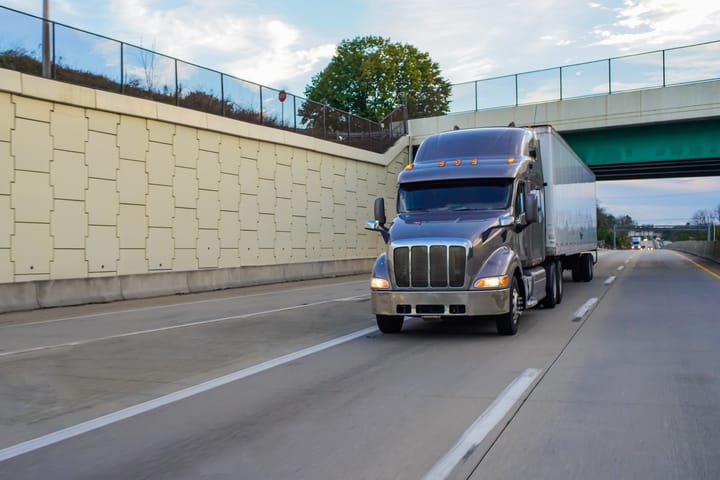Trucking: What's in store for 2025
Industry leaders share insights for the year ahead and what they hope to leave behind.

As the end of year approaches, the trucking industry is gearing up for 2025. What will next year have in store for the sector, its drivers and freight markets?
We spoke to industry experts — from fleet executives to a truck driver — to hear their top trends and predictions for 2025. - Shefali Kapadia
The answers below have been edited for brevity and clarity.
The Experts
Dennis Anderson chief strategy and innovation officer at ArcBest
Russell Hoyt director of education at MG Truck Driving School and 3rd generation truck driver
Frank Granieri COO of supply chain solutions at A. Duie Pyle
Artie Crawford director of cybersecurity, National Motor Freight Traffic Association
Jeff Martin VP of global sales strategy, Lytx
American Trucking Associations: national trade association for the trucking industry
What predictions do you have for future trucking trends in 2025?
DA: The need for agile, flexible operations amid disruption and volatility
The need to become more efficient and more flexible has been at the forefront for years, but I expect it will become increasingly more important to remain competitive. Some disruptions, like seasonal demands, can be anticipated. But others, like weather events, are less predictable. Policy changes resulting from a new administration, skilled labor shortages, capacity imbalances and fluctuating freight demand also play significant roles in shaping the industry. We can’t say for sure what will happen, but it’s important to keep an eye on these areas because any changes can impact logistics planning and shipping costs. It’s another case where agile and adaptive strategies will be critical for mitigating potential impact.
RH: Tax cuts, lower fuel prices and several new drivers
Tax cuts are likely under the new administration, which means more money spent, and manufacturing is going to take off again. We can also expect a lot of new drivers. Many current drivers are at the age of retirement, so positions will open up over the next year, as well as just a general increase of employment opportunities due to increased work. I also anticipate that we will see record-breaking numbers for women joining the industry. More women have been pushed to join the industry to become more self-sufficient.
FG: Government and policy-related changes
By 2025, anticipated changes in trade policy and tariffs will incentivize domestic production and nearshoring, reducing reliance on global supply chains. Government investment in transportation infrastructure also has the potential to elevate the entire logistics industry.
ATA: A rebound in consumer spending on goods
Growth in goods spending was stifled after the initial boom early in the pandemic, outpaced by growth in services spending. Moving into 2025, we expect to see goods spending growth return to pre-pandemic averages. This gradual improvement is the best-case scenario. Most drivers of truck freight will remain the same, or improve slightly, in 2025 compared with 2024. However, these predictions are notwithstanding policy changes enacted by the incoming administration.
AC: An escalation in cyber-enabled cargo theft
Criminals have pinpointed weaknesses in the current trucking and supply chain business processes and technologies that will allow continued exploitation of the industry until addressed. With the increasing sophistication of attacks and the availability of force-multiplying tools like AI and advanced automation, the exploitable target surface available to bad actors continues to increase. We are seeing trucking and logistics companies get hit with cyberattacks with increasing frequency. The increasing number of internet of things (IoT) and operational technology devices in the industry, coupled with the convergence of these devices into the enterprise network, increases the likelihood for active exploitation with each passing year.
JM: Friendlier in-cab video telematics and AI-powered coaching for drivers
Safety will remain a leading priority for fleets. Fleets will leverage video to support drivers and offer positive reinforcement for what they do right, which is a fundamental shift from years of fleets focusing on what went wrong. In addition, the implementation of AI-powered coaching will take distracted driving prevention to the next level by enabling drivers to self-correct unsafe driving behaviors like texting or talking while driving in real time.
What's one trend you'd like to see stick around in 2025?
ATA: Low diesel prices
Diesel prices have slowly but surely moderated over the last two years, with recent prices around $3.458 per gallon countrywide. The continuation of moderating diesel prices will help offset the otherwise rising costs across the industry.
AC: Increased cyber resilience in the trucking industry
There has been a shift toward prioritizing cybersecurity and resilience by peers sharing more openly with one another about lessons learned from cyber events. These conversations about threat actors and threat vectors, and the need for robust cybersecurity controls in trucking, continue to improve the cybersecurity landscape throughout the industry.
JM: Fleet managers’ receptiveness to data and analytics
Fleet managers only have so much time amid a heavy workload, and they need to be able to maximize their coaching time with drivers. We’d like to see managers continue to lean in and leverage data in their safety programs, while also going from big data to best data — data that is aligned with company KPIs and metrics to keep coaching and training simple.
RH: The use of AI
We use a simulator to help with training, and it has helped prepare our drivers in the best way possible.
DA: Accelerated adoption of responsible AI and machine learning
In my role (and as a tech guy), I am particularly excited about the transformative potential that AI and machine learning hold to help make employees’ jobs easier and make supply chains more efficient. We’ve seen it first-hand in our City Route Optimization project. This AI-powered route planning has resulted in positive business impact in several areas, including more dense city routes, fewer miles driven, less fuel consumption, reduced carbon footprint and increased productivity. As a result of implementing CRO, in 2023, we saved approximately 186,500 gallons of fuel and reduced our emissions by approximately 1,900 metric tons of CO2.
What's one trend or issue you wish would go away in 2025?
FG: A potential port strike
The looming potential for a port strike in January 2025 is a significant concern. If it occurs, it could cause widespread disruptions in the supply chain, particularly in the movement of goods through key U.S. ports. Delays at the ports would ripple through the logistics network, affecting everything from inventory management to delivery timelines. This uncertainty adds strain to an already complex supply chain.
DA: Constant disruptions plaguing the industry
These disruptions have the potential to wreak havoc and often keep both large and small business owners up at night. However, it seems this supply chain reality is not going away any time soon, so our goal is to help customers navigate it with our large capacity network, robust technology and reliable data.
RH: Overregulation
I believe regulations will be cut with the new administration, as it has hurt a lot of different companies.
JM: Risky driving
With return-to-office mandates resurfacing in the new year for so many companies, both fleet drivers and passenger vehicles face heightened roadway risk, as there will be a greater number of vehicles on roads and highways. As a result, fleets will need to intensify their driver training and safety programs so that drivers are well equipped to navigate and avoid risks.
ATA: High interest rates and low industrial production
Elevated mortgage rates have held the housing market in a weak point for over two years. Both single family homes and existing home sales have slowed and continue to be a drag on freight, even as pent-up demand for housing remains. In addition, industrial production has been consistently down over the last two years because of lower demand for goods. Low factory production has been a headwind for freight, particularly LTL freight, and we will need to see factory output improve in order to see tailwinds for the industry.
AC: The tendency of the human element to increase organizational risk
This can take the form of poor passwords and password management practices, or susceptibility to social engineering attacks and email phishing (no, your long-lost rich uncle is not a Nigerian king, and he will not actually send you $5 billion if you click here right now).
Thanks for reading today's edition! You can reach the newsletter team at editor@theinsidelane.co. We enjoy hearing from you.
Interested in advertising? Email us at newslettersales@mvfglobal.com
Was this email forwarded to you? Sign up here to get this newsletter twice a week. Be safe out there!
The Inside Lane is curated and written by Shefali Kapadia and edited by Bianca Prieto.





Comments ()